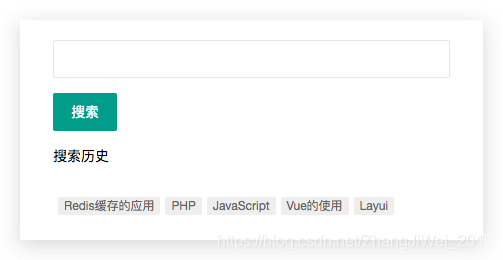



<!DOCTYPE html><html><head><meta charset="utf-8"><title>Redis应用 - 搜索历史</title><!-- 引入 Layui CSS --><link rel="stylesheet" href="css/layui.css"></head><body><div class="layui-form" style="width: 50%;margin-top: 20px;" id="app"><div class="layui-form-item"><label class="layui-form-label"></label><div class="layui-input-block"><input type="text" class="layui-input"></div></div><div class="layui-form-item"><label class="layui-form-label"></label><div class="layui-input-block"><button class="layui-btn">搜索</button></div></div><div class="layui-form-item"><label class="layui-form-label"></label><div class="layui-input-block">搜索历史</div></div><div class="layui-form-item"><label class="layui-form-label"></label><div class="layui-input-block"><span class="layui-badge layui-bg-gray" style="margin-left: 5px;">PHP</span><span class="layui-badge layui-bg-gray" style="margin-left: 5px;">JavaScript</span></div></div></div><!-- 引入 jQuery --><script src="js/jquery-3.5.1.min.js"></script><!-- 引入 Layui JS --><script src="js/layui.js"></script><!-- 引入 Vue.js --><script src="js/vue.min.js"></script></body></html>
给文本框添加 Vue 双向绑定
<input type="text" class="layui-input" v-model="keyword">
给搜索按钮添加点击事件
<button class="layui-btn" @click="addHistory()">搜索</button>
<script type="text/javascript">var vm = new Vue({el: "#app",data: {keyword: ""},methods: {addHistory: function () {}}});</script>
当文本框被输入内容后,输入的内容将绑定给 Vue 中 data 的 keyword 字段。
点击搜索按钮时,触发 addHistory() 函数,此函数将输入的内容发送给 PHP ,PHP 操作 Redis 将内容进行缓存。
addHistory() 函数中:
addHistory: function () {$.ajax({url: "history.php",type: "GET",data: {type: 'add', keyword: this.keyword},success: function () {// 请求成功后刷新本页面window.location.reload();}});}
data 中传值两个字段,type 表示本次请求的类型,其中 add 代表往缓存中添加关键字,read 代表从缓存中读取关键字。
history.php 中:
<?php$redis = new Redis();$con = $redis->connect('localhost', 6379);if (!$con) {echo 'Redis连接失败';}// 接收请求类型参数的值$type = $_GET['type'];// 模拟用户的id,因为每个用户搜索的内容不同,需要进行区分$user_id = 'user-1';// 如果请求类型为添加if ($type == 'add') {// 接收输入的关键字$keyword = $_GET['keyword'];// 读取当前用户队列中存储的关键字个数,即队列的长度$len = $redis->llen($user_id);// 如果个数大于等于 5 个,则删除最开始搜索的关键字,加入最新搜索的关键字if ($len >= 5) {// 移除队列左侧的第一个关键字$redis->lPop($user_id);// 在队列右侧加入新的关键字$redis->rPush($user_id, $keyword);} else {// 不多于 5 个直接在队列右侧加入新的关键字$redis->rPush($user_id, $keyword);}}
第二步中加入了当请求添加缓存成功后会刷新页面的代码,
window.location.reload();
在这个基础上,我们希望刷新的同时执行另一个 Ajax 请求从 PHP 中操作 Redis 将所有的历史搜索关键字读取出来并在页面中展示。
所以在 Vue 中加入页面加载完成自动调用getHistory()函数:
methods: {getHistory: function () {},addHistory: function () {$.ajax({url: "history.php",type: "GET",data: {type: 'add', keyword: this.keyword},success: function () {window.location.reload();}});}},// 页面加载完成自动调用 getHistory()created () {this.getHistory();}
getHistory()函数中:
getHistory: function () {$.ajax({url: "history.php",type: "GET",data: {type: 'read'},success: function (r) {// JSON.parse(r) 将读取到的 json 字符串转为 json 对象vm.history = JSON.parse(r);}});}
data 中传值一个字段,read 代表从缓存中读取关键字,请求成功后将返回的结果赋值给 Vue 中 data 的 history 字段。
history.php 中添加读取操作:
// 如果请求类型为读取if ($type == 'read') {// 从队列左侧依次取出 5 个关键字$history = $redis->lrange($user_id, 0, 4);// 转为 json 格式的数据并输出到页面中供 Ajax 使用echo json_encode($history, JSON_UNESCAPED_UNICODE);}
将读取到的数据成功赋值给 Vue 中 data 的 history 字段后,页面中即可将数据循环输出展示:
<span class="layui-badge layui-bg-gray" v-for="item in history" style="margin-left: 5px;">{{item}}</span>
连贯过程为:用户输入关键字并点击搜索按钮,Ajax 请求 PHP 操作 Redis 进行数据缓存且缓存成功后刷新页面,页面刷新后自动调用函数执行 Ajax 请求 PHP 操作 Redis 进行缓存数据的读取并返回于页面中同时进行渲染展示。